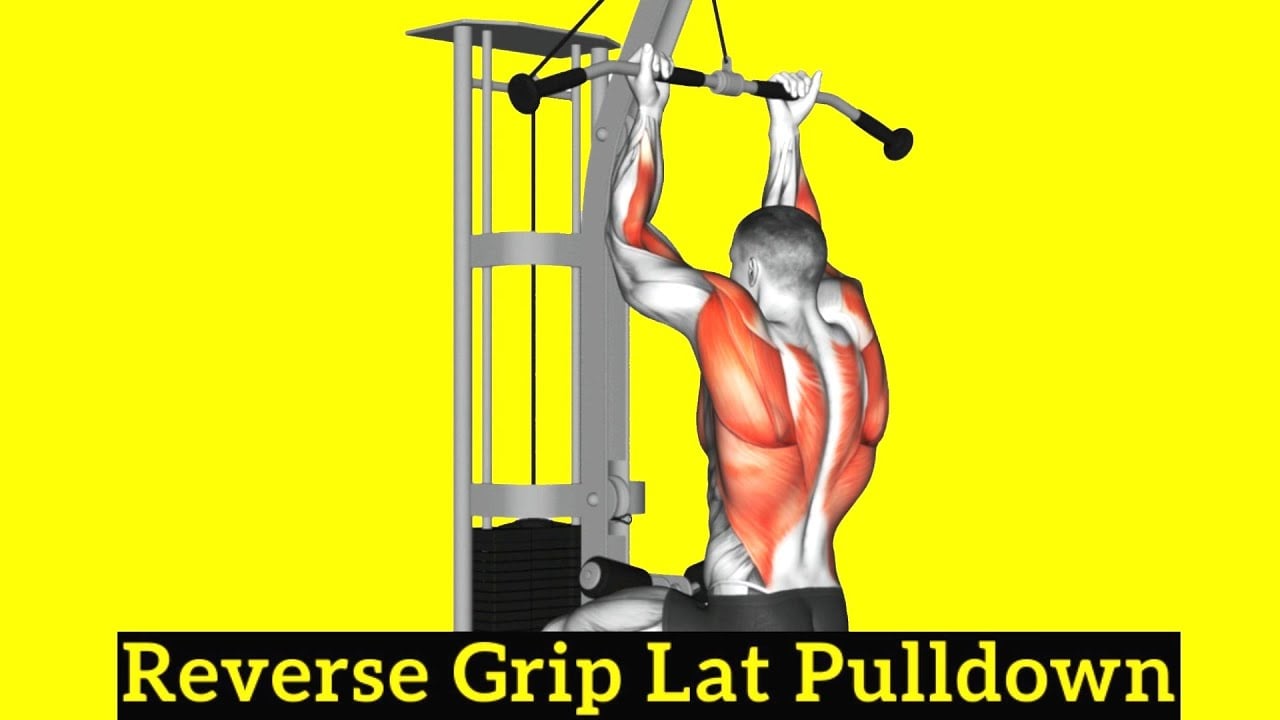The reverse grip lat pulldown, also known as the Underhand Grip Lat Pulldown, is a popular back exercise that targets the upper back muscles uniquely compared to the traditional lat pulldown.
In this move, you grasp the pulldown bar with an underhand (reverse) grip, slightly wider than shoulder-width apart. The underhand grip puts more focus and tension on the upper back muscles, mainly the lats, along with the rear deltoids, Rhomboids, trapezius and bicep.
A wide-grip pulldown emphasizes the lats more, whereas a reverse-grip variation also significantly stresses the upper back’s smaller and often neglected muscles.
Want to take your gains to the next level? Discover your daily calorie needs with our free TDEE calculator
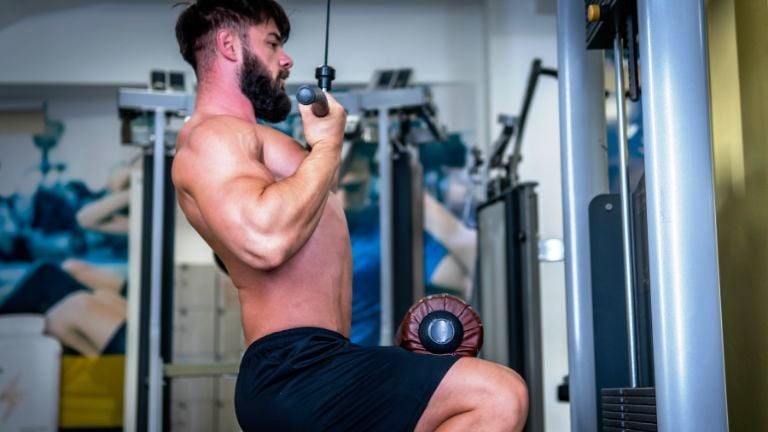
Reverse Grip Lat Pulldown Muscles Worked
- Primary Muscles Worked: Latissimus Dorsi, Lower Trapezius.
- Secondary Muscles Worked: Rhomboids, Biceps Brachii, Brachialis, Brachioradialis, Teres Major, Serratus Anterior, Infraspinatus and Teres Minor and Core Muscles
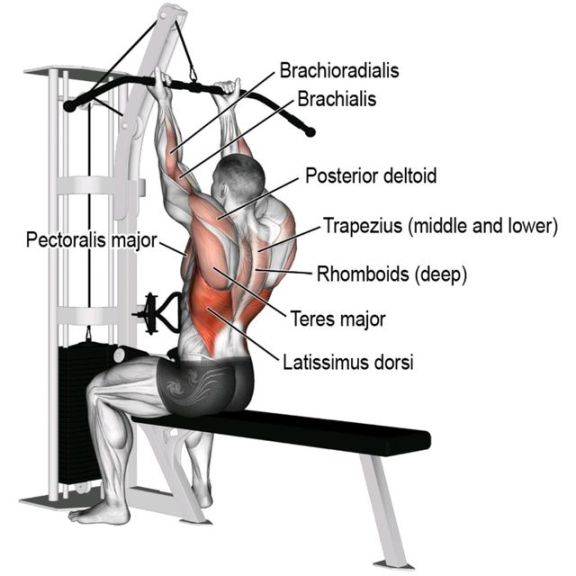
How To Do Reverse Grip Lat Pulldown
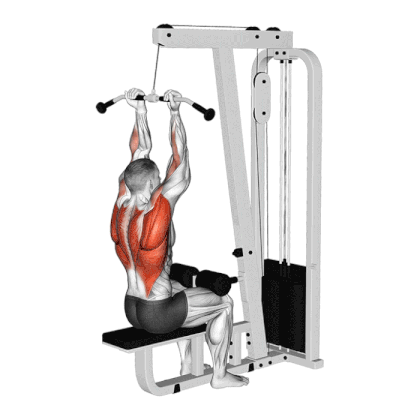
- Sit down on the lat pulldown machine and place your thighs under the knee pads.
- Grip the bar with your palms facing you (underhand/supinated grip).
- Your hands should be spaced closer than shoulder-width apart for optimal muscle engagement.
- Sit down with your arms fully extended, back straight, and chest up.
- Your feet should be flat on the floor. This is your starting position.
- Take a deep breath and engage your core muscles.
- Start pulling the bar downwards toward your upper chest.
- As you pull the bar down, focus on driving your elbows toward the ground.
- Your forearms should move vertically and come to a stop when the bar reaches your upper chest.
- Hold the position briefly and consciously squeeze your lat muscles for maximum contraction.
- Release the bar slowly with your arms fully extended, then slowly return it to the initial position. Exhale during this phase.
- Perform the desired number of repetitions and sets.
To Stay Motivated: 150+ Gym Workout Motivational Quotes To Stay Fit
Tips and Form
- Avoid rounding your back, keep your core strong and pull with your lats instead of your lower back. It’s one of the most common mistakes made when doing lat pulldowns, and it can lead to lower back pain.
- Maintain an upright posture, leaning slightly back, just enough to prevent the bar from hitting your face. Excessively leaning back can disengage the latissimus dorsi and put unnecessary strain on your lower back.
- Avoid using momentum to finish a rep. Instead, use your back muscles to pull the bar down towards your chest.
- Control the negative on the way down. Don’t just let gravity drop the weight.
- If you feel your biceps being overused and your back remaining under active, consider utilizing a false grip.
- If the exercise is performed too quickly, without control, it can lead to poor muscle engagement and increase the risk of injury.
- Grab the bar properly and at an equal distance on both sides. The bar’s improper grip, whether excessively wide or narrow, can impact the targeted muscles and may result in discomfort or strain.
- Make sure you fully extend your arms at the starting position and pull the bar down at the upper chest level. Additionally, focus on squeezing the shoulder blades together at the bottom of the movement.
Underhand Grip Lat Pulldown Variations and Progressions
Here are some variations and progressions to help you target different areas of your back and continue progressing in your workouts.
1. Wide Grip Underhand Lat Pulldown
The wide grip underhand lat pulldown is a vertical pulling variation that targets the lats and upper back muscles. As the name suggests, you use a wide underhand (reverse) grip on the bar, wider than shoulder-width apart.
Using a wide grip underhand lat pulldown, you can build wing-like lats and increase upper body muscle mass.
Note: While a wider grip can target the outer portion of your lats, using a too wide grip may put excessive strain on your shoulders and elbows. Test out different grip widths to find the one that feels right and allows you to perform the exercise in the right way.
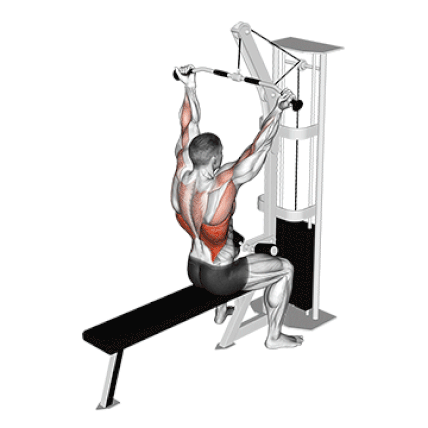
2. Single-Arm Reverse Grip Lat Pulldown
In a standard bilateral pulldown, one side may compensate for the other side if there is a strength imbalance. The single-arm variation minimizes this risk, as each side of the body is working independently and effectively.
The single-arm variation allows greater focus on each side and improves latissimus dorsi and biceps muscle activation.
The single-arm version often allows a greater range of motion and also allows for a more natural movement pattern.
Reverse Grip Vs Standard Grip Lat Pulldown
Both the Reverse Grip (Underhand) and Traditional Grip (Overhand) Lat Pulldowns are effective exercises for targeting the latissimus dorsi.
However, they offer distinct advantages and engage secondary muscle groups in distinct ways. Here’s a comparative look at the two:
| Aspect | Reverse Grip | Traditional Grip |
|---|---|---|
| Muscles Targeted | Emphasizes upper back – rear delts, rhomboids, traps | Emphasizes lats more directly |
| Grip and Hand Position | Uses underhand grip wider than shoulder width | Uses overhand grip wider than shoulder width |
| Range of Motion | Allows greater stretch at bottom by tilting torso slightly | Hits optimal lat contraction at various angles |
| Benefits | Builds upper back thickness and rear delt development | Builds lats for width and v-taper |
| Downsides | Limits lat involvement compared to traditional | Can cause shoulder impingement if poor form |
| Best Uses | As a supplementary exercise to target the upper back | As a core lat builder, often done with wider grip |

Manish is a NASM-certified fitness and nutrition coach with over 10 years of experience in weight lifting and fat loss fitness coaching. He specializes in gym-based training and has a lot of knowledge about exercise, lifting technique, biomechanics, and more.
Through “Fit Life Regime,” he generously shares the insights he’s gained over a decade in the field. His goal is to equip others with the knowledge to start their own fitness journey.

